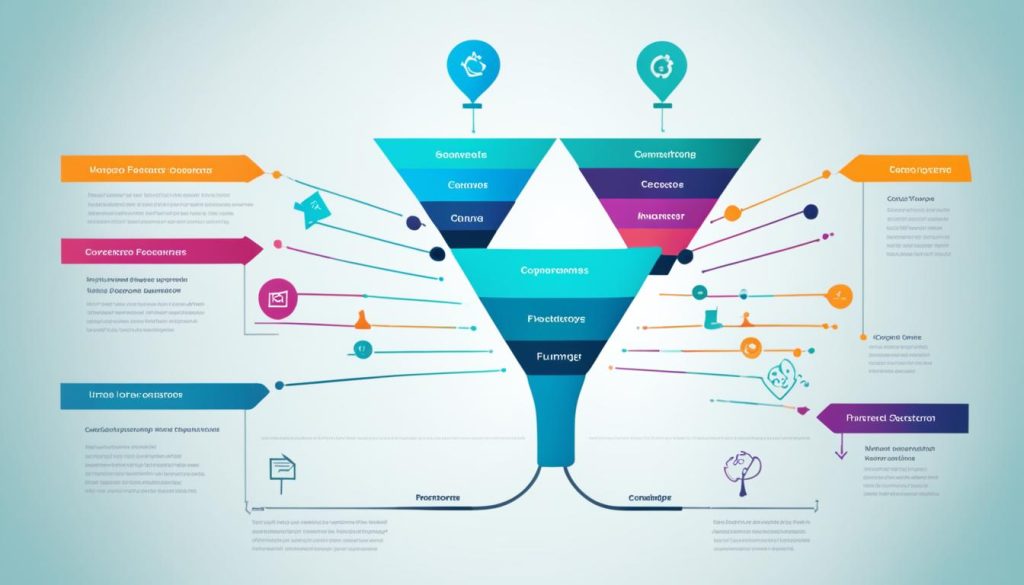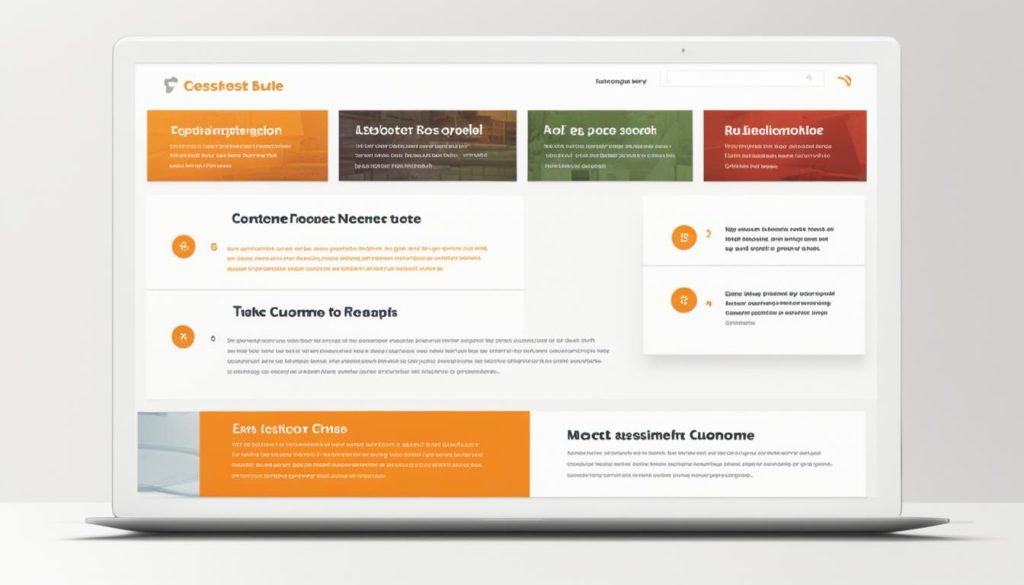Did you know you can turn readers into customers directly with sales links, or by getting their emails and sending updates? As a content marketer, you might be glad your blog is seeing more visitors. But, if you haven’t looked closely, you might be missing out on how much money those visitors bring in. So, when the boss asks, “How much revenue did the blog make last month?” you might not have a ready answer.
Finding out how much your blog makes is key to using it for smart money-making strategies. Wondering if your blog is doing everything it can to make money? This guide will show you the steps to turn your blog guests into dedicated buyers. Plus, it’ll help you see real cash flow for your business.
Identifying the Two Primary Conversion Funnels
When wanting your blog readers to become paying customers, focus on two main areas. These are direct links to sales pages and getting your reader’s emails. This helps with both email marketing and lead nurturing. Knowing about these funnels helps you better your strategy. You can see how well each method works.
Converting Through Direct Links to Sales Pages
The simplest way to convert visitors is by using direct calls-to-action (CTAs). These CTAs lead directly to your product or service pages. It turns visitors into buyers fast. They can buy with just one click.
Capturing Reader Emails and Nurturing with Email Marketing
Another approach is to collect emails and then send them follow-up emails. While this method takes longer, it helps you build strong connections with your readers. You can slowly guide them to make a purchase.
By concentrating on these main funnel types, you can track their success. This will help you make your strategies better. Your blog can earn more through these efforts.
Measuring Conversion Rates with Google Analytics
Want to know how many customers you get from blog visits? Start by using ‘blog to customer’ analytics. The quick way is to create conversion goals in Google Analytics. You can track actions like signing up or buying. Then, check your conversion rate measurement to see how well your content works.
Setting Up Conversion Goals in Google Analytics
Setting conversion goals in Google Analytics helps you track actions that mean a successful sale. For example, sign-ups, purchases, or content downloads. It shows how your blog’s visitors are turning into real sales or sign-ups.
Using the Landing Pages Report to Analyze Conversion Rates
The Landing Pages Report in Google Analytics tells you how well your blog is doing. It shows conversion rates, total conversions, and revenue from different pages. This insights can help find what content works best and improve your blog conversion strategy.
With conversion goal tracking and the Landing Pages Report, you’ll understand how blog visits help your business make money. This detailed view is critical for your strategy and bottom line.
Tracking Conversion Paths with Funnels and UTM Parameters
You can learn a lot about how your visitors convert by using conversion funnels and UTM parameters. These tools show you the exact steps visitors take before converting.
Setting Up Funnels to Visualize Conversion Paths
With conversion funnels, you see how many people go through each step to convert. This process highlights where they might get stuck or leave. It helps you find areas to improve and make your decisions based on real data to boost conversion rates.
Using UTM Parameters to Track Traffic Sources
UTM parameters track where your website traffic comes from. By using UTM tags on links in your blog posts, you can see which sources bring the most visitors who actually convert. This helps you spend your marketing budget better.
Both conversion funnels and UTM parameters provide important insights. They help you understand and improve how visitors convert and where they come from. This means you can enhance your strategy and increase your blog’s earnings.

Optimizing Link Placement for Better Conversions
When you focus on making your blog better at turning visitors into fans, where you put your links really matters. It’s more than just having great calls to action. It’s about putting them in the right places in your writing.
The best spot for your key conversion rate optimization links is where everyone sees them first. Think about using banners, sidebar widgets, or CTA buttons at the top of your posts. This way, readers can’t miss them.
Use other tricks, too. Add links within your text or CTAs that fit what you’re talking about. This makes moving to the next step easy for your readers, like signing up for a free trial or buying a product.
How your page looks is crucial.Make sure what you want people to click on stands out. Then, place the other CTAs so they go well with what your readers are doing.
When you plan well where to put your links, you can lead your readers the right way. This could be getting their email, buying something, or any other action you’d like them to do.
Converting Blog Traffic into Revenue
If you’re a business owner or a marketer, you know how crucial it is to turn Blog Traffic Monetization and Content Monetization Strategies into real money. Your blog is doing well, bringing in over 100,000 people to your client sites every month. But, what’s tricky is making money from this traffic.
Over the next few weeks, we’ll share strategies to make your blog bring in cash. Today, we’ll look at the big picture and where to put CTAs. This way, you’ll have a good answer for those asking about your Blog Traffic Monetization efforts.
The secret to turning visitors into buyers is knowing about two main paths: sending them directly to sales pages or getting their emails for email marketing. Setting conversion goals in Google Analytics is key. It helps track your strategies’ performances so you can improve them.
It’s not just about looking at how many people buy. It’s also about understanding the journey they take. Funnels and UTM parameters can shed light on where your traffic comes from. This will help improve your Content Monetization Strategies.
By following these steps, your blog can become a valuable source of income for your business. Keep an eye out for more tips on maxing out your blog’s earning potential and growing your business sustainably.
Showcasing Value and Benefits Over Features
Your website might not be turning visitors into customers if it focuses solely on features. Instead, it should show how your products and services can solve problems. Customers need to see real benefits before buying anything.
Adopting a Feature-to-Benefit Mindset
It’s better to think in a feature-to-benefit mindset. Avoid just listing features. Show how those features lead to actual benefits for customers. By adopting this value-based selling approach, you can improve your customer-centric marketing.
Painting a Relatable Picture for Potential Customers
Describe how your offerings can improve customer lives. This could be by making things easier, saving time or money, or helping reach goals. This feature-to-benefit mindset helps share your business’s true value. It leads to more conversions.

Providing a Great User Experience
Imagine you run a website that sells courses. It’s not just about a nice design and good content. It’s also important that your site is easy to use and pleases visitors old and new. A great user experience begins with a well-managed website.
Ensuring Easy Navigation and Fresh Content
Your site should be simple to navigate and always updated with new things. This keeps people interested and happy. A website that’s both easy to use and current is more likely to draw people in and keep them exploring.
Leveraging Website Management Tools Like MemberPress
After making your site user-friendly and current, think about using a tool, such as MemberPress. It helps you manage your website better, dealing with things like user sign-up, what content users can see, and managing subscriptions. These tools save you time, letting you focus on making your site better for everyone.
Optimizing Website Design for Conversions
To turn visitors into customers, your website needs to be clean, user-friendly, and visually attractive. A bad design can turn people off, lowering your chances of making a sale. Research shows 94% of bad feedback is because of websites’ designs.
Creating a Clean and Responsive Layout
For a design that helps convert, keep fonts and colors simple. Make sure important information stands out. Navigation should be clear so visitors find what they need fast. It’s also key that your site works well on all devices, as 8 in 10 people say they’ll leave if it doesn’t.
Utilizing Page Builders and Professional Design Services
Not a pro at web design? No worries, try Page Builder Tools. They come with easy drag-and-drop features. This lets you create a professional site without much hassle. Or, you could invest in getting help from experts. They can design a site that not only looks good but also converts visitors into customers.

Creating High-Quality and Relevant Content
Your website’s content quality hugely affects how many visitors become customers. If your content is bad or not convincing, people won’t stay long enough to buy. Typically, visitors give a website’s content just 5.59 seconds. So, having engaging and relevant content is key, especially when focused on target keywords.
Prioritizing Content Quality and Relevance
To make visitors act, focus on content quality and content relevance. Your content should be well-researched, informative, and meet what your visitors need. This builds trust and makes them more likely to do what you want on your site.
Leveraging VPNs for Comprehensive Keyword Research
To create great content, start with deep keyword research. A VPN can be handy because it lets you see search terms as if you’re in various places. This way, you understand your audience better and can make content that truly fits what they need.

Implementing Effective SEO Strategies
Effective SEO is key for online success. It helps your site get seen by more people. Almost 70% of all site visits come from search engines, showing how crucial SEO is.
It’s tough to be seen online. A huge portion of content doesn’t get any clicks from Google. This is why a strong SEO plan is essential.
Good SEO strategies cover many areas. They include finding the right keywords, making top-notch content, and fixing your website’s tech bits. Local SEO is also vital since many Google searches look for nearby things. This can boost both online and in-store business.
SEO doesn’t work overnight. It often takes 3 to 6 months to see real changes. This means sticking with it and being patient is key for success.
Getting lots of quality backlinks is also a big part of SEO. Google sees them as a major factor in ranking sites well. Yet, most pages don’t have backlinks. Working on your backlink network helps improve where you show up in search results and brings more people to your site.

Attracting the Right Traffic to Your Website
If you marketed baby skincare to adult men, you’d make some sales. But, it wouldn’t be enough to even buy a burger. So, if your website isn’t doing well, you might be attracting the wrong people.
Auditing Your SEO Strategy and Targeting the Right Keywords
So, to fix this, you need to check your SEO strategy. Make sure you use keywords that match your audience. This way, you’ll get more visitors who are likely to buy from you.
Promoting Your Website on the Right Social Media Platforms
Don’t forget to market on the right social media platforms. Go where your customers hang out online. Instagram, Facebook, and LinkedIn are good choices. They can bring you more visitors and improve your social media presence.

